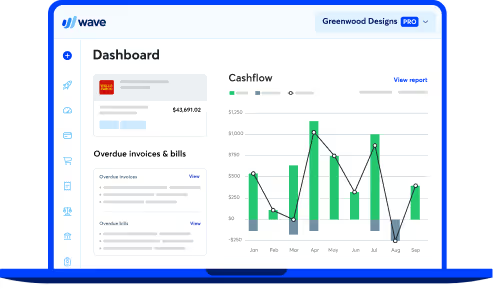
How to create a cash flow projection (and why you should)
For small business owners, managing cash flow (the money going into and out of your business) can be the difference between a thriving, successful company and filing for chapter 11 (aka bankruptcy).
In fact, one study showed that 30% of businesses fail because the owner runs out of money, and 60% of small business owners don’t feel knowledgeable about accounting or finance.
Understanding and predicting the flow of money in and out of your business, however, can help entrepreneurs make smarter decisions, plan ahead, and ultimately avoid an unnecessary cash flow crisis.
After all, knowing whether the next month will see a financial feast or famine can help you make better decisions about spending, saving, and investing in your business today.
One way to do this (without hiring a psychic)? Cash flow projection.
If, for example, your cash flow projection suggests you’re going to have higher than normal costs and lower than normal earnings, it might not be the best time to buy that new piece of equipment.
On the other hand, if your cash flow projection suggests a surplus, it might be the right time to invest in the business.

Cash flow projections: The basics
In order to properly create a cash flow forecast, there are two concepts you should be aware of: accounts receivable (cash in) and accounts payable (cash out)
- Accounts Receivable: refers to the money the business is expecting to collect, such as customer payments and deposits, but it also includes government grants, rebates, and even bank loans and lines of credit.
- Accounts Payable:refers to the exact opposite—that is, anything the business will need to spend money on. That includes payroll, taxes, payments to suppliers and vendors, rent, overhead, inventory, as well as the owner’s compensation.
A cash flow projection (also referred to as a cash flow forecast) is essentially a breakdown of expected receivables versus payables. It ultimately provides an overview of how much cash the business is expected to have on hand at the end of each month.
Cash flow projections typically take less than an hour to produce but can go a long way in helping entrepreneurs identify and prepare for a potential shortfall, and make smarter choices when running their business.
(and create unique links with checkouts)
*While subscribed to Wave’s Pro Plan, get 2.9% + $0 (Visa, Mastercard, Discover) and 3.4% + $0 (Amex) per transaction for the first 10 transactions of each month of your subscription, then 2.9% + $0.60 (Visa, Mastercard, Discover) and 3.4% + $0.60 (Amex) per transaction. Discover processing is only available to US customers. See full terms and conditions for the US and Canada. See Wave’s Terms of Service for more information.
Manage your business finances with Wave.
Send invoices, get paid, track expenses, pay your team, and balance your books with our financial management software.
How to calculate your cash flow projection
Calculating your cash flow projection can seem intimidating at first, but once you start pulling together the necessary information, it isn’t so scary. Let’s walk through the first steps together.
1. Gather your documents

This includes data about your business’s income and expenses.
2. Find your opening balance
Your opening balance is the balance in your bank at the start of a period. (So, if you’ve just started your business, this is zero.)
Your closing balance is the amount in your bank at the end of the period.
So the opening balance in one month should equal the closing balance at the end of the previous month. But more on this later.
3. Receivables (money received/cash in) for next period
This is an estimate of your anticipated sales (such as invoices you expect to be paid, or payments made on credit), revenue, grants, or loans and investments.
4. Payables (money spent/cash out) for next period
Again, this is an estimate. You should consider things like materials, rent, taxes, utilities, insurance, bills, marketing, payroll, and any one-time or seasonal expenses.
“Seasonality can have a material effect on the cash flow of your business,” Andy Bailey, CEO of Petra Coach, wrote in an article for Forbes. “A good cash flow forecast will anticipate when cash outlays and cash receipts are higher or lower so you can better manage the working capital needs of the company.”
5. Calculate cash flow
Now, let’s bring it all together using this cash flow formula: Cash Flow = Estimated Cash In – Estimated Cash Out
6. Add cash flow to opening balance
Now, you’ll want to add your cash flow to your opening balance, which will provide you with your closing balance.
Put it all together: How a cash flow projections look on paper
In practical terms, a cash flow projection chart includes 12 months laid out across the top of a graph, and a column on the left-hand side with a list of both payables and receivables.
Here are all the categories you’ll need for your cash flow projection:
- Opening balance/operating cash
- Money received (cash sales, payments, loans, investments, etc.
- Money spent (expenses, materials, marketing, payroll and taxes, bills, loans, etc.)
- Totals for money received and money spent, respectively
- Total cash flow for the period
- Closing balance
This column typically begins with “operating cash”/opening balance or unused earnings from the previous month. For example, if your cash flow projection for January suggests a surplus of $5,000, your operating cash for February is also $5,000.

Below operating cash, list all expected accounts receivable sources—such as sales, loans, or grants—leaving a space at the bottom to add them all up.
Next, list all potential payable items—such as payroll, overhead, taxes, and inventory—with another space to add their total below.
Once you have your numbers prepared, simply subtract the total funds that are likely to be spent from the cash that is likely to be received to arrive at the month’s cash flow projection.
Once you’ve calculated your monthly cash flow, take the final number and list it at the top of the next month’s column under operating cash, and repeat the process until you’ve got a forecast for the next 12 months.
After the end of each month, be sure to update the projection accordingly, and add another month to the projection.
If you’re a Wave customer and you prefer to use a ready-made chart to help you create your projection, you can pull your financial data from the Reports section of Wave and feed it into this cash flow forecast template.
Be realistic with your cash flow forecast
Cash flow projections are only as strong as the numbers behind them, so it’s important to be as realistic as possible when putting yours together.
For example, being overly generous in your sales estimates can compromise the accuracy of the projection.
Furthermore, if you provide customers with a 30-day payment schedule and a majority pay on the last possible day, make sure that cycle is accurately reflected in your projection.
On the payables side of the equation, try to anticipate annual and quarterly bills and plan for an increased tax rate if the business is likely to reach a new tax level.
Those who pay their staff on a bi-weekly basis also need to keep an eye out for months with three payroll cycles, which typically occurs twice each year.
“Monthly or quarterly forecasts generally are more useful for stable, established businesses,” Bailey also wrote. “Weekly projections will be essential for companies scaling up or going through significant changes, such as a restructuring or merger/acquisition.”
“We like to encourage business owners—especially those who are starting out—to create a 13-week forecast for cash,” William Lieberman, the Managing Partner of The CEO’s Right Hand, told Forbes. “Each week, update the forecast based on what happened the previous week and extend the forecast window by one more week. In this way, you can keep a close watch on exactly what’s coming in and going out so you can be more proactive in managing cash flow crunches.”
Those who want to be extra cautious with their projections can even include an “other expenses” category that designates a certain percentage of revenues for unanticipated costs. Putting aside some extra cash as a buffer is especially useful for those building their first projections, just in case they accidentally leave something out.
What now: Use your cash flow forecast to make data-driven decisions
Building the cash flow projection chart itself is an important exercise, but it’s only as useful as the insights you take away from it. Instead of hiding it away for the remainder of the month, consult your cash flow projection when making important financial decisions about your business.
If, for example, you anticipate a deficit in the months ahead, consider ways to cut your costs, increase sales, or save surpluses to help make up the difference. If you notice that payments often come in late, consider introducing a late penalty for bills past due.
You can also consult your cash flow projection to determine the best time to invest in new equipment, hire new staff, revise your pricing and payment terms, or when to offer promotions and discounts.
Improving the accuracy of cash flow projections over time
Once you’re in the habit of creating cash flow projections, it becomes easier to improve their accuracy over time.
Comparing projections to actual results can help you improve the accuracy of your cash flow projections, and help identify longer-term patterns and cycles. Seasonal changes in revenue, patterns that contribute to late payments, and opportunities to cut costs will all become more apparent with each new cash flow projection.
While all these benefits won’t come all at once, entrepreneurs can use their cash flow projection to become better operators and better decision makers with each passing month.
Cash flow projection FAQs
How do cash flow projections affect business decisions, and how can small business owners improve their accuracy?
Cash flow projections play a key role in how you make business decisions by giving you important info on the movement of money in and out of your business You can up their accuracy by regularly updating projections, comparing them to actual results, and adjusting for any discrepancies. This helps you make smart choices about spending, saving, and investing in your business.
What industry-specific factors should small business owners consider in cash flow projections?
Small business owners need to consider various industry-specific factors when creating cash flow projections. For instance, seasonal changes in revenue, payment cycles, and market trends can significantly impact cash flow. By analyzing these factors, you can tailor your projections to better reflect the realities of your industry and adjust your strategies accordingly.
How can small business owners make sure their cash flow projections are reliable?
Small business owners often face challenges in making cash flow projections due to uncertainties in revenue, expenses, and market conditions. To ensure reliability, you should try to be realistic in your estimates, account for potential fluctuations, and regularly update your projections based on actual performance. Additionally, seeking advice from financial experts and using tools like cash flow forecasting templates can help with these challenges and improve the accuracy of projections over time.
Made for small business owners, not accountants.
The information and tips shared on this blog are meant to be used as learning and personal development tools as you launch, run and grow your business. While a good place to start, these articles should not take the place of personalized advice from professionals. As our lawyers would say: “All content on Wave’s blog is intended for informational purposes only. It should not be considered legal or financial advice.” Additionally, Wave is the legal copyright holder of all materials on the blog, and others cannot re-use or publish it without our written consent.


























